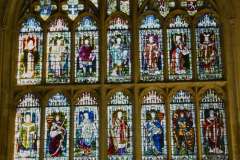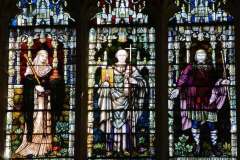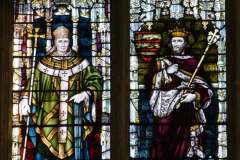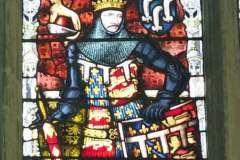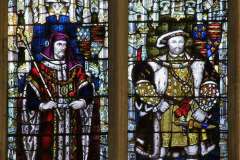The glass in this window dates from 1896 when the Chapter House was restored to commemorate the 1300th anniversary of the coming of Augustine. It was donated by the Freemasons of Kent. There are 21 main lights and these depict the people that were seen to be important in the history of the cathedral as at that time (Image 1)
Starting at the top left, there is Queen Bertha who together with King Ethelbert, next but one, welcomed Saint Augustine, who is shown between them, when he arrived in Canterbury in 597. Archbishop Theodore of Tarsus is next, he organised the church into parishes. Following windows in row 1 are of St Alphege, who was martyred by the Danes in 1012; first Norman archbishop, Lanfranc who rebuilt the Saxon church in 1070; and St Anselm, who was the second Norman archbishop and had the present crypt built around 1100.
In the second row, there is St Thomas Becket who was martyred only a few metres away in the Martyrdom as a result of the anger of Henry II (recorded incorrectly as III) who is shown next. Archbishop Stephen Langton was responsible for the translation of Becket’s body into the new Trinity Chapel in 1220 with great ceremony. Another archbishop, Edmund Rich follows after which is recorded Edward I who married his second wife, only a few metres away on the steps of the Martyrdom in 1199. The Black Prince is buried in the Trinity Chapel and is shown on black armour as the Victorians considered, incorrectly, that that is how he received his pseudonym. Lastly is Archbishop Simon Sudbury who was decapitated during the peasants’ revolt and buried (minus head) in the cathedral in 1381.
On the bottom row is Henry IV who is buried close to his uncle the Black Prince followed by his namesake, Henry VIII, who was responsible for the destruction of Becket’s shrine and subsequently the dissolution of the priory in 1540. There now follow three archbishops of Canterbury, Thomas Cranmer and William Laud who both died for their faith and John Tillotson. Next, Archbishop Benson appears, followed by the reigning monarch, Queen Victoria.
What to see:
- In the top row, Queen Bertha, Augustine and King Ethelbert who started the cathedral in 597 (Image 2)
- In the second row, Thomas Becket and Henry II (oddly marked in error as Henry III) who made Canterbury Cathedral a major pilgrimage site for 370 years (Image 3)
- Also in the second row is the Black Prince who is buried in the Trinity Chapel (Image 4)
- In the third row, two kings who were particularly important, one who is buried here, Henry IV and the other for what he destroyed, Thomas Becket’s shrine, Henry VIII (Image 5)
AT

